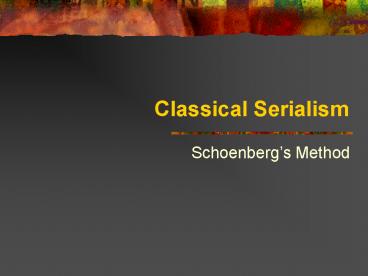Classical Serialism - PowerPoint PPT Presentation
1 / 13
Title:
Classical Serialism
Description:
Tone Row (basic set, series): An ordered arrangement of the twelve pitch classes ... The Tone Row ... This is also the system used in Allen Forte's set class theory. ... – PowerPoint PPT presentation
Number of Views:104
Avg rating:3.0/5.0
Title: Classical Serialism
1
Classical Serialism
- Schoenbergs Method
2
The Development of the Method
- Many composers felt that a regular cycling of all
the pitch classes was the best way to achieve
atonality. - Schoenberg developed the idea of arranging the
twelve pitch classes into a row. - The fugue theme from Thus Spake Zarathustra and
Ives Three-Page Sonata are examples of
twelve-note melodies that predate Schoenbergs
method. - These, and other examples, did not use the twelve
pitch classes systematically throughout the
compsosition. - Schoenbergs method uses the row as the basic
shape of the composition that can only be
presented in four ways.
3
Terminology
- Tone Row (basic set, series) An ordered
arrangement of the twelve pitch classes with each
occurring only once. - Prime The original set.
- Retrograde The original set in reverse order.
- Inversion The mirror inversion of the original
set. - Retrograde Inversion The inversion in reverse
order. - Order Numbers The notes position in the row.
4
The Tone Row
- Notes can be written in any octave (octave
equivalence) and enharmonically (pitch class). - Each form has 12 transpositions, creating 48
versions of the row. - Rows are identified by an abbreviation of which
of the four basic forms is being used and a
number from 0 to 11.
5
The Tone Row
- There are two ways that the numbers 0 - 11 (not
to be confused with Order Number) are assigned to
the pitches. - The old way -- presented in the book -- assigns 0
to the first pitch of the original set,
regardless of what pitch class it actually is,
and the following numbers are half-steps above
that pitch. - For instance, if the first four pitches of row
are E, F, G, C-sharp, then the numbers would be
0, 1, 3, 9.
6
The Tone Row
- The newer way -- which has become widely accepted
and which we will use -- assigns the numbers to
the pitch classes regardless of which is the
first pitch of the original set (0 is C, 1 is
C-sharp, etc.). - This is also the system used in Allen Fortes set
class theory. - P-0 therefore indicates a prime form of the row
starting on pitch class C. - A matrix, or magic square, presents all 48
versions of the row. - From left to right are the prime forms, top to
bottom the inversions, right to left the
retrogrades, and from bottom to top the
retrograde inversions.
7
Analyzing a Row
- Sing or play the row listening for sequences or
familiar patterns. - Since composers usually try to avoid any
reference to tonality, pay particular note to any
segments that are triads, scale segments, or
traditional bass and melodic formulas. - Tabulate the interval classes between adjacent
pitches (not an interval vector). - Some rows emphasize particular intervals, others
do not. - If there are two of every interval class except
IC6 it may be an all-interval row.
8
Analyzing a Row
- A derived set uses the first 3, 4, or 6 notes as
a pattern and then transposes, inverts, and/or
retrogrades this cell to generate the rest of the
row. - Patterns of ICs may reveal patterns that are
transposed, inverted, retrograded, and/or
overlapped in a series. - An invariant PC is one that is shared by any two
pitch collections.
9
Analyzing a Row
- An invariant subset is on that appears intact in
two forms of the row. - The PCs must be in the same ordering to be
invariant. - Analyze the subsets for their PC set types.
- Analyzing the trichords and tetrachords is
usually enough. - The first and last hexachord will be either the
same type or Z-related. - The other PC sets will overlap too much to be of
much use.
10
Compositional Uses
- The forms of the row can be presented
consecutively or simultaneously. - The notes can be in any octave.
- The order of a row form is usually preserved, but
notes may be sounded simultaneously as well as
consecutively. - The are not rules regarding how simultaneous
notes are arranged in the chord.
11
Compositional Uses
- Repeated notes or tremolos are not considered to
alter the row. - Both presenting different forms of the row
simultaneously and distributing a single form of
the row across different parts are common. - It is less common to overlap segments of the row
or to reorder it for compositional purposes.
12
Compositional Uses
- All 48 forms of the row are rarely used.
- The combining of two row forms to create an
aggregate is called combinatoriality. - Usually a hexachord from each set is used to
create a secondary set. - The combining is most often done vertically.
- Rows have to be specifically constructed to work
-- most rows can not be used combinatorialy. - Combinatoriality is considered by some to be an
extension of the 12-tone technique -- it
garuntees a more controlled recycling of the
twelve pitches.
13
Analyzing Serial Music
- Just labeling the rows and the consideration of
the details of their use is only part of an
analysis. - Form, thematic relationships, etc., are just as
important as in tonal music. - Use your ears!
- The use of a serialized row is only a way to
control the pitch material -- not a system of
composition.































